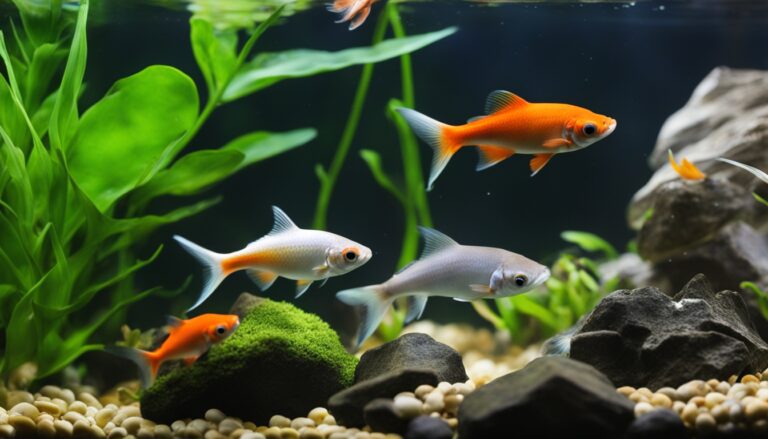Have you ever watched Chili Rasboras light up a freshwater aquarium? I’m always on the hunt for the perfect nano fish, and these little gems — Boraras brigittae — really stood out with their vibrant colors and friendly personalities. Even though they’re tiny, they pack a big punch when it comes to adding life and color to your tank.
First described in 1978, Chili Rasboras, also known as Mosquito Rasboras, stay small — only about 2 cm. They prefer soft, acidic water, with a pH between 4.5 and 7.5, and can live up to 5 years if kept in the right conditions, which is around 74 – 82°F (23 – 27°C). While their care might require a bit of attention to detail, it’s definitely manageable.
Breeding these little guys can be super rewarding if you’re patient. It takes about 2 to 3 days for the eggs to hatch, and watching the fry feed off their yolk sacs is pretty fascinating. The key to success is recreating their natural Bornean environment, complete with dense plants and peat-filtered water.
In this guide, we’re going to explore what makes Chili Rasboras so special. We’ll dive into how to breed them, understand their behavior, and figure out which tank mates they’ll get along with best. Let’s get your tank set up to be a perfect home for these colorful fish.
Whether you’re a seasoned fishkeeper or just starting out, Chili Rasboras bring a lot of excitement. Their bright red bodies and distinct black stripe make them peaceful, eye-catching additions to any small tank, turning it into a lively aquatic scene.
Introduction to Chili Rasboras
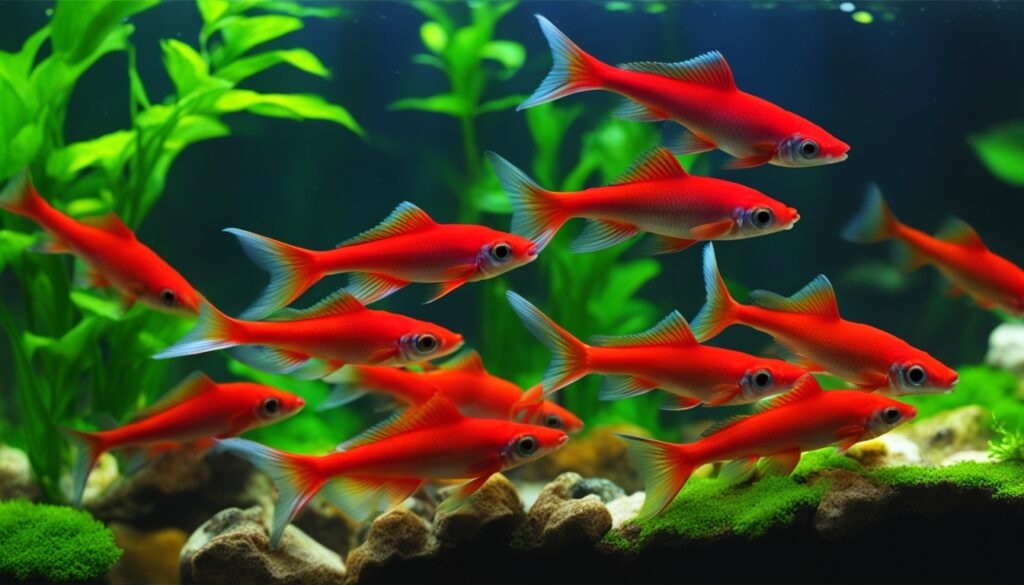
Explore the captivating realm of Chili Rasboras. These nano fish dazzle any aquarium with their bright colors. They stand out as vibrant aquarium fish. Fish enthusiasts love them for their lively appearance and behavior.
The Alluring Aesthetics of Chili Rasboras
With their fiery red bodies and bold black markings, Chili Rasboras are striking. Their colors get bolder as they grow, reflecting their health. Despite their small size, around 0.75 inches, they make a big impact in groups.
Natural Habitat and Origin
Chili Rasboras come from the rainforests of Indonesia and Borneo. They live in blackwater streams, dark from tannins. These streams have soft, acidic waters, similar to their natural homes. This environment supports Chili Rasboras and the diverse aquatic life they live with.
Why Chili Rasboras Make Great Pets
Chili Rasboras are beautiful and adaptable, perfect for any fishkeeper. They fit well in various tanks, even needing just a 5-gallon one for a few. They are calm, making them great with other small, peaceful fish. Chili Rasboras are a top choice for adding color and life to tanks easily.
Aquarium Conditions for Chili Rasboras
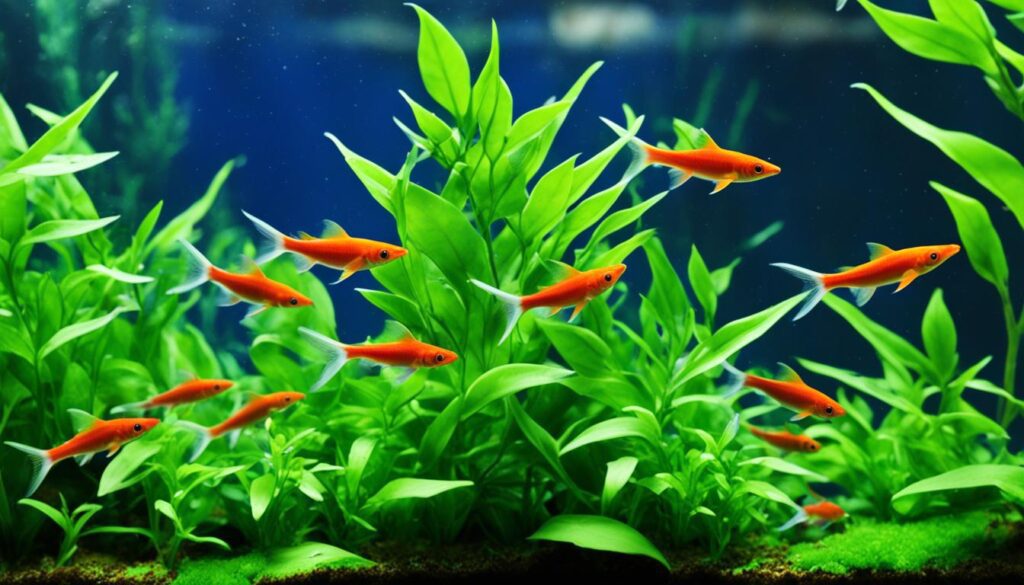
Getting the right set-up for Chili Rasboras boosts their health and color. It also makes their behavior more interesting and helps them live longer. We will look into tank setup and choosing plants.
Tank Size and Configuration
A 10-gallon tank is good for starting a small group of ten chili rasboras. These fish are tiny, around 0.6 to 0.8 inches long, and they like peaceful settings. Having more room lets them show their natural behavior, which is fun to watch. So, a bigger tank is better if you have the space.
Water Parameters for Optimal Health
Keeping the water right is vital for Chili Rasboras. They do best in water that’s slightly acidic to neutral, with a pH of 4.0 to 7.0. It’s important to keep their water at 72°F to 82°F. This matches the warm waters they come from. The water should be soft to moderately hard, with a hardness of 3.0 to 12.0 dKH. Changing the water regularly, about 10% to 15% each week, helps keep everything balanced.
Lighting, Filtration, and Plant Recommendations
These fish don’t need strong light. A tank with moderate lighting is just right for them. It’s similar to the shady streams in Indonesia where they’re from. This setup is cozy for the fish and is great for plants that don’t need much light, like Java Fern and Anubias.
A sponge filter works well in a Chili Rasbora tank. It cleans the water without strong currents that could bother them. Plants help with filtering the water and provide hiding places. Adding different plant types, like Cryptocoryne, makes the tank look natural and keeps the environment healthy.
Parameter |
Ideal Range |
|---|---|
pH Level |
4.0 – 7.0 |
Temperature |
72°F – 82°F |
Water Hardness (dKH) |
3.0 – 12.0 |
Tank Capacity |
Minimum 10 gallons |
With the right care and setup, your Chili Rasboras will show off their bright colors and fun behaviors. Making their tank like their natural home makes them happiest. It turns your tank into a little piece of their world.
Diet and Feeding Habits
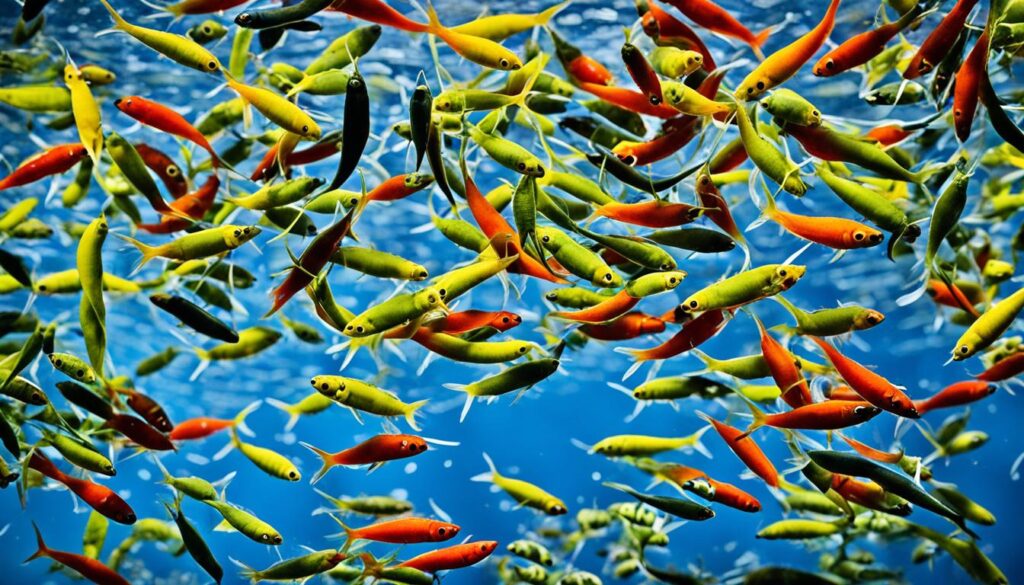
It’s key to know what Chili Rasboras eat to take good care of them. They love eating a mix of micro pellets and aquatic invertebrates, just like other omnivore fish. Giving them a variety of foods suits their small size and meets their needs.
When feeding Chili Rasboras, the food size matters. It has to be small enough for their little mouths. High-quality flakes or pellets work well if crushed into tinier pieces. For added nutrition, baby brine shrimp or micro-worms are great. They offer proteins and encourage their instinct to hunt.
These fish prefer to eat in the middle of the water. So, slow-sinking pellets are perfect for them. Feed them little but often, so they can eat it all quickly. This keeps both the fish and the tank in top shape.
To really bring out their color, include special foods in their diet. Foods rich in krill or astaxanthin work wonders on their red color, making them brighter.
A varied diet boosts their health and makes them look more colorful and lively. This makes your aquarium a more stunning place.
Food Type |
Benefits |
Frequency |
|---|---|---|
Micro Pellets |
Easy to consume, balanced nutrition |
Daily |
Frozen Bloodworms |
High protein, stimulates natural predation |
2-3 times per week |
Color-enhancing Flakes |
Enhances red coloration, complete nutrition |
Alternate days |
The right food makes Chili Rasboras not just survive, but thrive. They’ll show their best colors and playful ways, delighting anyone who watches them in a lush aquarium.
Chili Rasboras Behavior and Temperament
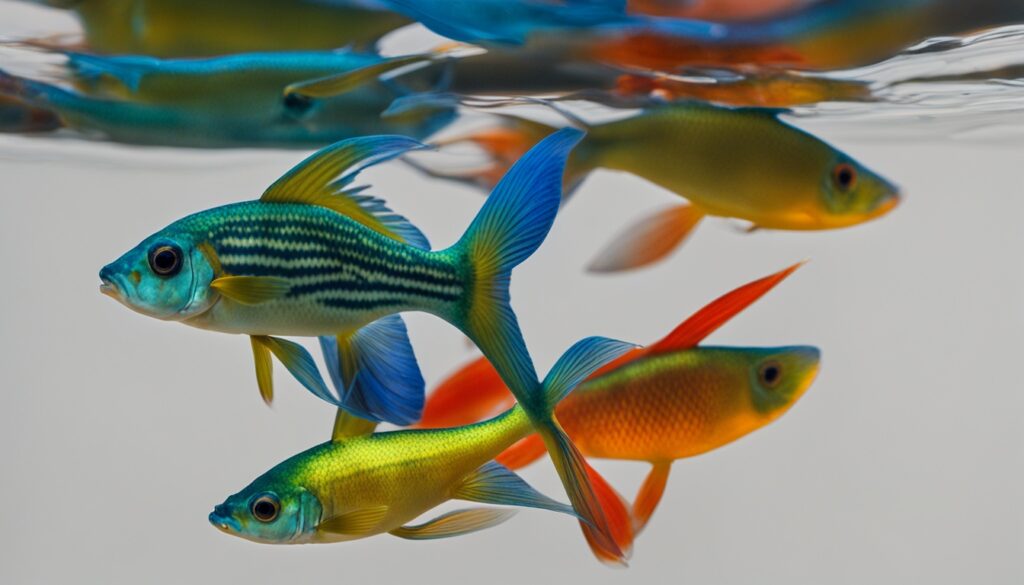
Chili Rasboras are among the most peaceful aquarium fish. They are loved by aquarists for their bright shoaling behavior. In home aquariums, they stick together in groups. This behavior is not just for survival. It also shows how fish interact with each other.
These small fish do best in groups. When they swim together, it’s beautiful. Watching them move among plants and tank decorations is amazing. Their group behavior boosts their safety and social bonds in the tank.
Social Dynamics: Shoaling and Schooling
The way Chili Rasboras school together is part of their appeal. They prefer groups of 8–12 or more. In groups, they feel safer and behave more naturally. This leads to more activity and brighter colors. A good mix of males and females encourages natural social behavior and breeding.
Identifying Gender Differences Among Rasboras
Knowing the differences between male and female Chili Rasboras is key for breeders. Males are brighter with black markings, especially when ready to breed. Females are bigger, rounder, and their colors are less bright. These differences matter for their behavior in breeding season.
Learning about Chili Rasboras makes keeping them more rewarding. It helps create a lively tank where these colorful fish can do well.
Chili Rasboras Breeding Guide
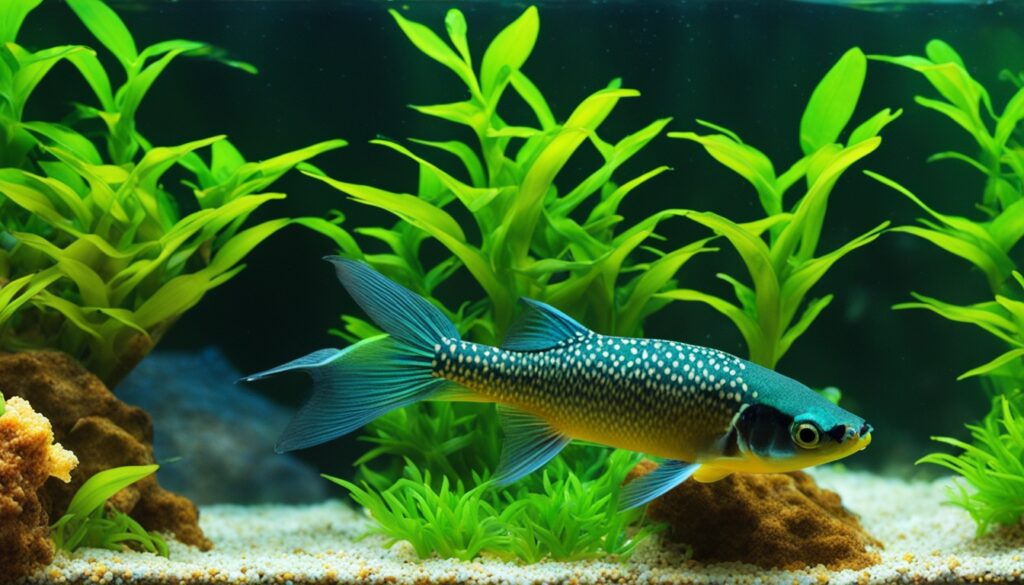
Welcome to the amazing journey of breeding Chili Rasboras. It’s filled with excitement and expectancy. As a fish breeding enthusiast, I’ve perfected techniques that embrace the joys and challenges of raising these colorful fish. I’m excited to share tips on creating the ideal breeding setup, taking care of the delicate fry, and promoting their development.
Preparing for Breeding: Tank Setup and Conditioning
To start, you need a special breeding tank for Chili Rasboras. I recommend tanks that are about 12″ long, 8″ wide, and 8″ tall, holding close to 12.5 liters. This gives the breeding pair plenty of room without making them feel cramped. The right water conditions are key; I keep the pH between 5.0 and 6.5. The hardness should be between 1-5°H. I find that temperatures between 72–82°F (22–28°C) work best to trigger spawning.
The Spawning Process and Egg Care
Chili Rasboras are egg scatterers and prefer laying eggs in fine-leaved plants or spawning mops at dawn. It’s important to remove the parents right after spawning to protect the eggs from being eaten. The eggs hatch in about two days. During this time, make sure the tank is dimly lit and undisturbed to help the eggs hatch successfully.
Growth and Development: Feeding Your Rasbora Fry
Feeding the rasbora fry is crucial after they hatch. At first, they will feed off their yolk sacs. Once that’s gone, I introduce Paramecium and similar microfoods. These foods are perfect because they’re small and won’t overwhelm the fry. About a week to ten days later, I start giving them baby brine shrimp and microworms. This helps them grow strong. A well-set-up breeding tank and careful breeding practices are key to raising more fry.
Parameter |
Value |
|---|---|
Recommended tank size (inches/cm/liters) |
12″ x 8″ x 8″ / 30cm x 20cm x 20cm / 12.5 liters |
pH range |
5.0 – 6.5 |
Water hardness (°H) |
1 – 5 |
Temperature range (°F/°C) |
72 – 82 / 22 – 28 |
Compatible Tank Mates for Chili Rasboras
When setting up community fish tanks, Chili Rasboras need careful tank mate selection. They are tiny, peaceful fish, measuring just ¾ inch. Dwarf Cory Catfish and Ember Tetras are great companions for them due to their small size. Neons and Glowlights also work well, adding vibrant color without outshining the Rasboras.
Choosing the right tank mates involves considering the rasboras’ safety. This is crucial during breeding times in planted tanks. Larger fish, like Pearl Gourami and Betta Persephone, are not suitable due to predation risks. Neon Green Rasbora and the colorful Rosy Loach make safer choices. Including shrimp, such as Cherry Barb and Crystal Red Shrimp, adds diversity and harmony to the tank.
Creating a peaceful community aquarium requires thought. A group of 8–12 Chili Rasboras can flourish with shrimp and snails. These pairings provide a mix of movement and interaction. This setup offers both a suitable environment for the species and turns your aquarium into living art. With species like Lambchop Rasboras and Dwarf Pencilfish, the tank becomes more than just a home. It showcases the beauty of harmonious aquatic life.
